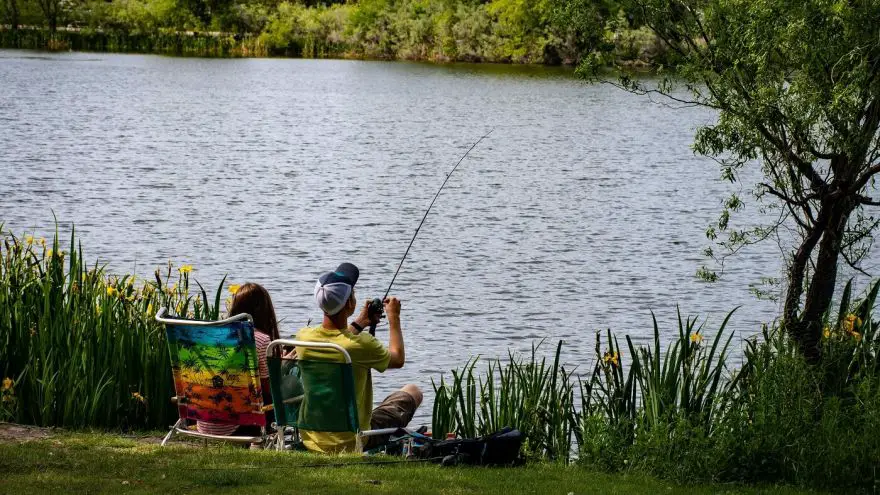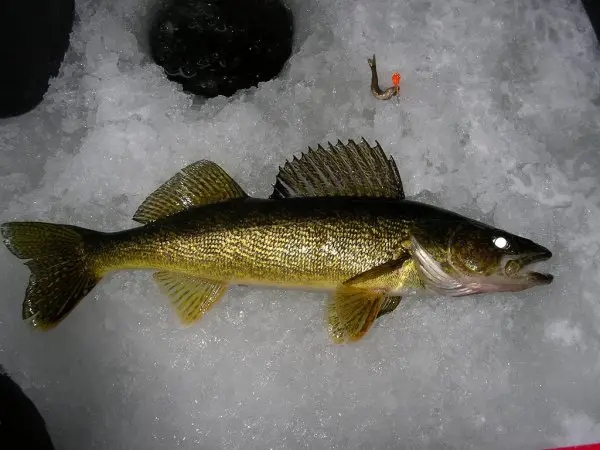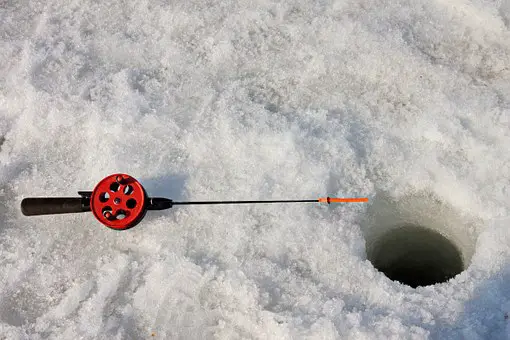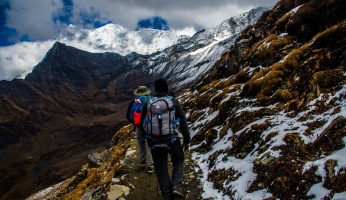Tips & Tricks for Ice Fishing for Walleye
 Tips & Tricks for Ice Fishing for Walleye
thegearhunt.com
Tips & Tricks for Ice Fishing for Walleye
thegearhunt.com
They just don’t seem to cease to amaze me. Not the walleyes themselves, but the anglers who try year after year to catch these fish. Those anglers who want the rules to be hard and fast. Who want to see the world of the walleye in plain black and white. The fact of the matter is that the world of the walleye exists in various shades of grey, especially when they are under ice.
That doesn’t mean that you won’t be able to determine the movements of this fish regardless of whether it is at the first, middle, or last ice. At least, not if you keep in mind that what can influence the activity of the walleye on small Minnesota lakes can vary greatly from what will influence them in Lake Ontario. These differences can and do affect the how, when and where of finding the elusive fish as it moves under the ice. In fact, you can fish for walleye on a variety of different ponds, pits, reservoirs, rivers, and lakes, and on so many various parts of this continent that many times, the only thing that remains constant is the fish itself.
The Migration Myth
We can refine our current understanding of the winter movements of the walleye by getting rid of the myth that says that this is a nomadic fish that is always moving and is prone to migrations that can cover long distances. While it is true that they do migrate in a few different reservoirs and lakes at a few times of the year, as a rule, during the winter months, this is just an oversimplification. Most of the movements of the walleye that ice fisherfolk tend to worry about aren’t movements that these fish make during the colder months at all.
 This myth might have gotten its start with a few mark and recapture studies that have been done – like the one that was done on Lake Champlain and showed that more than 60% of them at the north end migrated more than 30 miles down the river to end up in the St. Lawrence. Another study that was conducted on Lake Winnebago showed that 21% of the adult walleyes that were tagged were later recaptured as far as 90 miles from where they had been released. A few other studies regarding the movements of this fish have found that they can move as far as 240 miles!
This myth might have gotten its start with a few mark and recapture studies that have been done – like the one that was done on Lake Champlain and showed that more than 60% of them at the north end migrated more than 30 miles down the river to end up in the St. Lawrence. Another study that was conducted on Lake Winnebago showed that 21% of the adult walleyes that were tagged were later recaptured as far as 90 miles from where they had been released. A few other studies regarding the movements of this fish have found that they can move as far as 240 miles!
However, most of these studies have been conducted on reservoirs and lakes that were large. Also, they were associated with movements both before and after spawning. The walleye swam distances that were far in order to reach spawning grounds that were suitable or to return to their summer hangouts once spawning was completed. Little, if any, of the tracking was done or associated with their movements during the winter. In point of fact, it is due to the long-distance migrations that they make during and after spawning that we get some of the most stable and best ice action in the winter.
Many fishery researchers and biologists have postulated that the big water walleyes actually time their movements in the autumn that are long-distance to spawning grounds in order to take advantage of them being in the best physical condition of the year. It is better to make these migrations in the fall following the leisure life of the summer than in the spring when the egg-laden and winter weary females would be more stressed out regarding the exercise. Some of the winter fisheries surrounding the Red River in Manitoba, Canada, the Bay of Quinte, and Lake Erie are prime examples. With each of these, large schools of walleye will migrate vast distances during the fall months in order to settle and bunch up for the winter, and this will be near where they will spawn in the spring months.
The season for ice fishing is one that is mostly a time of relative stability that is characterized in most of the waters where the walleye are by long-distance movements that are minimal. Even when movements such as these do occur, they tend to represent the last part of the open water migration of the fall. The trickle of walleye in these rivers and lakes benefits the action of fishing.
Short Horizons
Do to the temperature of the water being colder and the metabolic rates that are slower, the walleye will move slower in the winter than they do during the summer. When they do happen to move horizontally going from one place to another, typically, the range will be one that is confined, with the pace being slow and measured, and the moves tend to be based on fishing pressure and shifts in forage.
That being said, when it comes to horizontal movement, it typically doesn’t happen at all. This is the reason that at the first ice, your best places to find this fish are typically the most classic structures for them on the lake, just as they are in the fall. It is also the reason for why on lakes that are multi-structured, when the pressure for fishing is light, you can typically sit on a single group of them in a single area for most of the winter.
Pointers
 One quite important thing that I have noticed in all of my years of fishing for walleye is that mainland and island points are great spots for fishing under the ice. That isn’t to say that they won’t hold on saddles, humps, bars, and reefs. However, in the winter, a good point is always a good spot to fish.
One quite important thing that I have noticed in all of my years of fishing for walleye is that mainland and island points are great spots for fishing under the ice. That isn’t to say that they won’t hold on saddles, humps, bars, and reefs. However, in the winter, a good point is always a good spot to fish.
I would imagine that what happens is just a sort of miniaturization of what is seen on bigger lakes like Huron, Ontario, and Erie, where they make treks in the late fall toward their springtime spawning areas. On the smaller island waters, the same type of movements occurs, just on a smaller subtler scale. That is why a rubble and rock mainland or the shoreline of an island spawning shoal will have walleye on their points all winter long.
Moving on Up
Walleyes might have most of their long-distance wanderlust behind them by the time we avid ice fisherfolk are drilling our holes in November, but that doesn’t mean that they completely stop all movement. What they do is to move vertically as opposed to horizontally – from shallow to deep, and then back up again. These shifts are triggered by levels of light and their own hunger.
Walleyes tend to be quite piscivorous (they eat mostly fish). They will eat suckers, alewives, sticklebacks, trout perch, and lake shiners. However, the smelt, lake herring (cisco or tullibee), and perch tend to be at the top of their dining menu. When those particular fish are in shallow water, the walleyes will move to where they are. When those forage fish go deeper, so will the walleyes. When they actually go on the move, so will the walleye, although they will typically position themselves on some type of structural element so that they will be able to intercept any sort of prey that is passing by. This positioning is typically along edges that are moderate to sharp breaking, as opposed to those that are on shallow flats. Whatever the case, if you find the forage fish, you will also find the walleye.
This idea of the expenditure of energy has been thoroughly documented for each species of game fish, from walleyes to muskies to small mouths. When the schools of shiners, tullibee, or perch are heavy on structures, the walleyes are not likely to move to another place. When the forage is thin or possibly migratory, the walleyes will become mobile out of necessity.
Winter will always mix things up a bit though. After spawning in the spring, walleyes can and do eat about 1% of their body weight each day. During the peak before the onset of summer, that amount doubles. In the summer months, when the temperatures of the water are perfect, the metabolic rate of the walleye races and their intake can equal about 3% of their body weight every day. However, in the colder months, when the temperature of the water dips below 54°F, the walleyes go into a stage of basically maintenance feeding. They will only ingest enough to keep them alive.
The Big Turn On
 When the walleyes feed during the winter, is yet another factor that will affect their activity patterns and movement on a daily basis. Dr. Dick Ryder from the Ontario Ministry of Natural Resources, along with Dr. Dwight Burkhardt from the University of Minnesota did a study that revealed that the eyes of the walleye are incredibly sensitive to light. It also found that the light actually affects the movement of this fish, while suggesting that the activity of feeding is most often triggered by how the levels of light change.
When the walleyes feed during the winter, is yet another factor that will affect their activity patterns and movement on a daily basis. Dr. Dick Ryder from the Ontario Ministry of Natural Resources, along with Dr. Dwight Burkhardt from the University of Minnesota did a study that revealed that the eyes of the walleye are incredibly sensitive to light. It also found that the light actually affects the movement of this fish, while suggesting that the activity of feeding is most often triggered by how the levels of light change.
Even though the levels of light underneath the ice remain at only about 10% of what they are during the summer. Dr. Ryder found that there were no changes or seasonal differences in the movement and feeding patterns of the walleye. The fish will continue to act in colder months just as they do in the warmer ones. Absolute levels of light aren’t factors that are critical. The switch that will stir the walleyes into feeding or moving, regardless of what time of year it is, is the rate of the overall change of the intensity of the light. This specifically speaks to the hour and a half around both sunrise and sunset. He also found that they will feed and move more heavily during the transition into evening than the one into morning.
Contour Fishing
Some of the more avid anglers have actually noticed this flurry of winter activity so often that they have actually come up with a list of things to do in order to take advantage of it. They will set up on a great underwater structure by early afternoon and predrill quite a few holes to cover the potential of shallow, mid-depth, and deep spots for feeding. It is essentially the winter version of contour trolling.
 Most of the time, the first wave of activity involving the walleye will happen in the holes that are the deepest. Then, someone will fly a flag or catch a walleye in one of the middle depth holes. Those will continue to be good spots for typically about ¼ of an hour. Finally, someone will haul a walleye up from a hole over shallow water. There is a rush to jig atop the actual structure. Anglers who are prepared will be able to follow this wave of fish up and over the structure they have chosen until it is pitch black outside and then it will be time to head home.
Most of the time, the first wave of activity involving the walleye will happen in the holes that are the deepest. Then, someone will fly a flag or catch a walleye in one of the middle depth holes. Those will continue to be good spots for typically about ¼ of an hour. Finally, someone will haul a walleye up from a hole over shallow water. There is a rush to jig atop the actual structure. Anglers who are prepared will be able to follow this wave of fish up and over the structure they have chosen until it is pitch black outside and then it will be time to head home.
The flurry of sundown activity will be super-charged during the months of December and January. Those months have short days and given the position of the best country for ice fishing in accordance with the sun, the schooling activity of the walleye, and the maintenance feeding traits of the walleye in those months, you will typically be able to get in about 30 minutes of walleye madness before there is a break in the action.
That being said, in March and April, you have longer days, and the frozen country in the North gets tilted a bit closer to the sun. Yes, the walleye will still be on their weight loss diet, but their activity will also be increasing. Do they need to feed heavily as they prepare to spawn? Do their demands for more energy go up as the eggs ripen? Maybe they are just reacting to the increasing amount of light?
It could be all of these things combined, which is the reason for the fact that the ½ hour of frenzy at the first ice will generally triple in time by the last ice. What better way is there to end a great season of ice fishing for walleye?
Sources
- You Tube, Early Ice Walleyes – Tips and Tricks to Catch More Walleyes
- Walleye Fishing Secrets, Intense Walleye Ice Fishing
- Jason Mitchell Outdoors, Ten Tips to Catch More Walleye with Jigs
- Fishing Minnesota, Ice Fishing Walleyes















